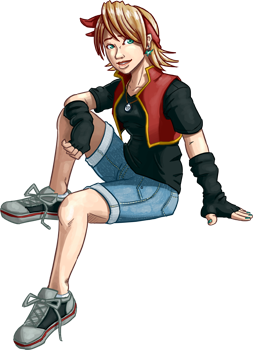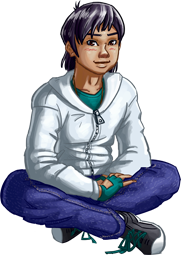It’s been a week and a half now since my last dev log entry where I noted that I was working towards a little playable build of the game for public release. I wanted to finish it by the end of the month. I haven’t made as much progress as I was hoping for, so it looks like I won’t have anything ready quite so soon. I just need to learn how to make games faster, I suppose.
But at least progress is being made, even if it’s not as quick as I was hoping. In the past week I’ve worked on getting the game’s item system up and running. The scripting commands needed for items to be usable haven’t been added yet, but almost everything else is done. This includes the inventory system, which is what I’m going to talk about today.

It’s hard to imagine an RPG without some sort of inventory system. Not that it can’t be done—it certainly can. But it’s such a fundamental simulation of how we store and use our tools and possessions in real life that it’s not just a cornerstone of RPGs, but of countless other genres as well. Items are usually very important in RPGs. You are an adventurer! Here is your sword! Here is your shield! Another Star 2, of course, is no exception.
Inventories in games tend to be broken down into two camps: infinite inventories that can hold everything, and limited inventories that only allow you to carry so many items (often based on weight, or count, or a combination thereof). Personally, I kind of like inventory management, so long as it’s not too tedious, which is the main reason why Another Star had a limited inventory.
For a limited inventory to work well, the player needs to have access to information about the usefulness of items, and they need to be able to understand how much room they have. Both of these allow the player to make informed decisions about what items to keep and what items to toss or sell. Older games tended to fail at the former. Many came with fold-out charts in the box along with the manual. If you didn’t have the chart, there was rarely an in-game way to find how powerful a given weapon or piece of armor is. Thankfully, improved display resolutions and better interface designs have pretty much nipped that problem in the bud.
Informing the player about the space left in their inventory still tends to be a problem, though. Bethesda games like Skyrim and Fallout are an example of this. Those games’ inventories are limited based on weight, but when it’s time to clear out your inventory it’s often a struggle to figure out where all the weight is. Is it a few heavy items, or many light items that are the problem? This is an area where Another Star failed, I think. In Another Star you had 50 item slots. Players usually didn’t realize this, though, because other than an untitled counter up in the corner of the inventory screen the game never really tells you up-front. Most players discover the item limit when they go to open a chest or buy something and the game suddenly tells them that they’re already full.
There are a few ways I want to approach this differently in Another Star 2. First off, you’ll notice that the inventory isn’t an old-style list of text, it’s icon-based. The graphics aren’t just to be pretty. They add some valuable information that text alone has trouble conveying. There are visible slots for items to be in, so it’s easy for the player to realize at a glance “oh, I only have this much room” without being explicitly told. Second, the inventory is going to be smaller at first. Maybe a dozen or so item slots at the beginning of the game. This means that the first time the player opens up the inventory, they’ll see that there are less slots on screen than there is room for, meaning they don’t have to scroll down before they realize the item slots don’t go on forever. It also lets them “practice” managing a small inventory early in the game that’s easy to track while they’re still figuring out how different sorts of items are useful. Don’t worry about the small starting inventory too much. Unlike the first Another Star, as this game goes on you’ll be able to earn more inventory slots.
One more thing I’d like to do is to better encourage the player to use their items instead of hording them just for boss battles. The first Another Star had lots of battle-minded items like nets and bait that were useful in certain situations. However, other than the throwing stars and bows, even I usually just sell them when I go back and play the game. I want items you find to look and sound like they’d be fun to use when you come across them so that you’ll want to try them out right away. I also want to make items like this more reliable. Why shouldn’t the net always immobilize or slow down low-level non-intelligent enemies instead of only working half the time? If it’s reliable instead of a gamble, people will want to make use of them because now they’re a dependable tactic in battle. Plus, if it isn’t as useful on bosses, players are likely to be less stingy with them.

The one thing I haven’t quite figured out yet is “key” items. These were a problem in Another Star. They took up room in your inventory, but the game would never deny you one when you were out of inventory room. What sometimes happened is that a player would end up with 51 items or more in their inventory because they’d just gotten some key items. They’d go sell a single item when told to free up room to buy something, then get confused when they still couldn’t buy the thing since their inventory was now at 50—still no room.
In my original notes for the game I planned to not have key items count towards the item total at all, but this might also be confusing, suddenly adding extra slots when you go over the limit just to have them disappear when you sell off items to make room. Most games tend to solve this by moving key items to their own special inventory, but I’m not sure this is a good idea for Another Star 2. In the first game, key items weren’t just MacGuffins that have no purpose. They were often items that you could equip, such as the very useful “Father’s Pendant” accessory acquired early in the game. If they’re all in their own little “key item” inventory, the player is less likely to remember them or even realize they can be used. I may make some sort of “overflow” inventory where key items get banished to when you acquire one but have no room for it.
I suppose I should also mention to two icons at the end of the inventory screen. The first is just a simple sort option, as pointed out in the caption above. Another Star 1 also had this. Selecting it multiple times in a row has the game sort your inventory by a few different criteria. I assume most people will use this if their inventory starts to get too cluttered instead of doing it all manually by hand, especially as the inventory size grows.
The second icon is more interesting to me, though. In my original mock-up image of the inventory I added a recycling symbol to the trash bin to make it more obvious that when you “drop” an item, you aren’t just throwing it away. As in the first game you get a little loot for it, although it’s just a pittance so that it’s still more worthwhile to hold on to it until you can sell it, if possible.
When I began working on the inventory this week, I went back to that mock-up in order to figure out where to put everything on the screen. When I did, I couldn’t remember at first why I made it a recycle bin icon and not an actual trash icon. It reminded me so much of the “recycle bin” in modern operating systems that I decided to just roll with it.

When you drop an item into the inventory’s recycle bin, you get your bit of loot, but the item isn’t actually disposed of yet. The most recent five items remain in the bin. If you change your mind, or pressed the button by mistake in a hurry, you can open up the recycle bin and select the item to get it back so long as you still have the loot from it, and have room in your inventory.
Now, it is possible in theory to abuse this mechanic to get five extra slots in your inventory. However, it’s not as simple as you might think. Nothing in the recycle bin is safe; not once you leave the status menu and go back to exploring. If you die in battle, the entire contents of the bin is gone forever even if you choose to retry the battle. They’ll also be gone if you ever reload a save. They aren’t even guaranteed to be there while just walking around as maybe they’ll start to randomly disappear from the bin after just a few seconds.

Well, that pretty much sums up the inventory and my thoughts on it. What are your preferences when it comes to the way games handle items? What are some of your examples of both good and bad inventory designs in games you’ve played?
I think my next goal now is to get the character status and equipment screens up and running. Hopefully those go more quickly.






